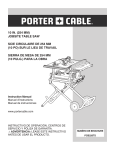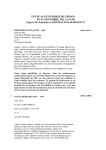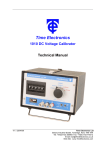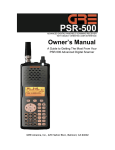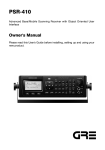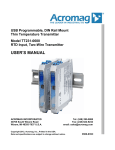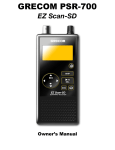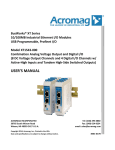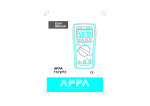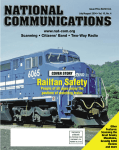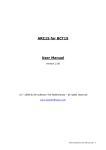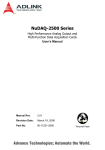Download PSR-500 Operating Hints - The RadioReference Wiki
Transcript
PSR-500 Operating Hints
The Object Oriented User Interface
Why doesn't my PSR-500/600 stop in the current Scan List when I
press the "MAN" button after the Scanner stops on an active Object?
You may have noticed that, when you are scanning and the scanner stops on an
active Scannable Object, and you press MAN to hold the scanner on the object,
the Scanlist and Object ID displayed in the upper left-hand corner of the LCD
display show a Scan List number that is not what you believe to be the
"current Scan List", or, the Scan List/Object ID display shows a Scan List
that you do not currently have enabled.
This is probably one of the more difficult things to explain about object
oriented scanning. The very short answer is as follows:
Once the radio begins scanning, it really doesn't know what the "current Scan
List" is.
A more detailed explanation is as follows:
In traditional bank/channel scanner designs, the scanner processes each bank
of channels individually and in sequence until all enabled banks are scanned,
then the process repeats. If you want a channel to appear in more than one
bank, for example, an important channel that you want to monitor regardless
of which banks you have enabled or disabled, you must make a separate copy of
it for each bank that you want it in, and, it will be scanned multiple times
in each scanning cycle if it is stored in more than one enabled bank.
Your PSR-500/600 does not work like this. It does not process Scan Lists
sequentially when scanning. Rather, it uses Scan Lists to organize your
Scannable Objects into logical groups of your choosing. We call this "mapping
objects to Scan Lists".
Scan Lists make it easy for you to find your objects, and make it easy for
you to enable and disable groups of objects when scanning. The objects aren't
really stored "in" Scan Lists. Rather, they are "members of" one or more Scan
Lists that you have identified in the Scan List mapping for each individual
object.
Once scanning begins, the radio doesn't know what Scan List(s) an object is a
member of. It just knows that an object it is scanning is mapped to one or
more enabled Scan Lists, and is not locked out. In this way it is possible to
have objects that are mapped to multiple Scan Lists, without having separate
and independent "copies" of an object for each Scan List that you want it to
appear in, making memory usage much more efficient, and making scanning more
effective, since the same object is not checked multiple times during a
single scan cycle.
It is important to remember that
the radio on an active Scannable
number Scan List that the object
and right arrow keys to navigate
when you press MAN while scanning to stop
Object, the radio always displays the lowest
is a member of. You may then use the left
to another Scan List if desired.
We suggest that you keep the following "OOUI Tenets" in mind as you use the
radio. If you find yourself confused or stuck about the basics of Object
Oriented Scanning, it may be helpful to review this list again.
The OOUI memory organization is nothing more than a large list of "Scannable
Objects". A "Scannable Object" is simply "something that can be scanned",
including conventional channels, trunking talkgroups, limit searches, service
searches and Spectrum Sweeper setups. In OOUI scanning, there are no
"systems", "banks", "groups", "sub-groups" or "ID lists". There is simply a
very large collection of objects, each with their own attributes. Scannable
Objects all exist at the same level or hierarchy within the scanner - no
single type of Scannable Object is more important than another, and Scannable
Objects do not have dependencies on or links to other Scannable Objects in
order for them to function properly. The primary method of grouping the
collection of objects is by mapping them to Scan Lists. Mapping a Scannable
Object to one or more Scan Lists does not change the physical location of the
object in the memory system. Even when an object is mapped to one or more
Scan Lists, the object itself has not moved nor changed from what it is - a
simple, standalone object that is part of a larger collection.
Operating Tips
Activate/Deactivate Scan Lists: Sets membership in Scan Lists. Use left and
right keys to scroll through Scan Lists. Use SEL key to toggle Scan List
membership. A "*" next to the Scan List number indicates that the object is
mapped to that Scan List.
Default Scanlist: When programming an object, select the scan list using the
menu or the default scan list one will be used. To return an object to your
selected scanlist, set the default the scanlist to the number you want.
To return an object to the default during EDIT or NEW press Dflt.
Dupe function: To repeat commonly used object attributes, use the Dupe
function.
Object access: To go to an object, press MAN or PGM and the object number,
then press E to go to the object.
Force Analog: If you have a CONV object that you know is analog, You can set
the object to tone search to force it as analog.
Force Digital: If you have a CONV object (or trunked) that you know is
digital, you can force it as digital by forcing it to search for P25 NAC.
Flex Step: "Super Expert Setting Menu". PGM, FUNC F3:GLOB Scroll down to
"flexStep" and Rt-Arrow it to "On" F1:Save. FlexStep allows entry of
frequencies that are a multiple of 1250 Hz except in the civil air band 108-136
where the step size is fixed at 8.333 kHz.
Audio Boost: Expert menu, AudioBoost, On or OFF, Applies a 6 dB boost to
audio levels when the object is active
EDACS expert settings: control how the scanner behaves after it has already
recognized a "call grant" message:
EndtoneEDACS - while on a "voice frequency", qualifying time in bits for the
"endtone" to indicate end of transmission
EDACS UnMute - after tuning to a “voice frequency”, a delay before unmuting
audio
EDACS ET HO - after returning to the CC from a "voice frequency", how long to
ignore any calls on the same "voice frequency"
Delete Alpha Characters during entry: Func + CL will delete all the
characters in a line. Use the "." (decimal) key to delete a character and
make a blank space.
Heap Error 21871F: 218E is often caused by having one or more TGRP objects that
aren't assigned to any TSYS. Either delete those TGRP objects or assign them to a
TSYS.
Battery Settings: Change the battery setting in the Global menu: Alkaline,
NiCad, or NiMIH, to set the proper battery warning levels for the battery type
you are using.
Quick Menu Move: Func + Up or Down will move to the top or bottom of a menu.
Go directly to a newly saved conventional object: Press MAN right after
pressing "Stor" in the search, you'll be taken right to the CONV object you just
stored.
Object Search: If you press manual, you can then scroll through the scanlist
(the default save to, is scanlist 1) with the up/down arrows. You can also
use the Find feature. press Program, Edit, Find enter a alpha text or
frequency. And you can find it by object type by pressing Program, Edit,
press left or right key to select the object type, such as CONV, the up
down arrow to select the conventional object.
Signal Strength Meter Settings: Settings of 470 540 610 680 750 provide a
wider range indication of signal strength than the default settings. To change
the settings, press PGM + FUNC + F3 (GLOB) and scroll through the menu to
RSSI Sig Cal. Press SEL and edit the entries for each RSSI Bar (1-5).
DG/Dg: means that a digital transmission is being received.
DG means that the digital AGC is on for that object being monitored.
Dg means that the digital AGC is off for the object being monitored.
PGM/FUNC/GLOB/DG Int Prime (or "Digital Detect Timeout" in Win500) controls
how long the scanner waits to automatically detect digital (P25 CAI)
transmissions, when the type of transmission isn't known / expected ahead of time.
This is in three cases:
1. MOT trunking systems (can be either analog or P25 CAI)
2. CONV objects where "Sq Mode" is set to "Search"
3. The various "searching" modes (TUNE, SWPR, SRCH)
A P25 TSYS isn't affected, as all voice transmissions must be P25 CAI. EDACS and
LTR systems aren't affected, as they must be analog. A CONV object whose squelch
mode is set to P25, CTCSS, or DCS isn't affected, as those settings imply the
voice type.
For example, here I listen to several CONV channels where I know the "voice type".
I set each one's Sq Mode to "force" either analog or digital. So, my CONV channels
aren't affected by the DG Int Prime setting. However, I also listen to two MOT
trunked systems - one is all analog, the other is all digital voice. If I set "DG
Int Prime" too low, the scanner pften gives up on waiting for digital on the
second system (giving me "motorboating"), though the first system's analog voice
is very fast. My "happy medium" for the two is 30 - corresponding to a 300mS delay
while waiting for digital. I do get that 300mS delay at the beginning of every new
transmission on the analog system, but I never get motorboating on the digital
system.
Pause vs. Man: PAUSE: stops on the currently-active TGRP object, does not
perform any "MultiSite" sequencing in the TSYS. If the current CC is lost
for some reason, the scanner *will* look through the TSYS's list for a new
one. You'll also see any alpha tags programmed for detected RadioIDs.
MAN: stops on the currently-active TGRP object, performs full "MultiSite"
sequencing in the TSYS. Any detected RadioIDs are shown as the "raw" ID
value - the scanner won't lookup any alpha tags you may have programmed
for those RadioIDs.
If you want to "pause on and follow" a particular talkgroup ID as its users
move between sites (sites that use different control channel frequencies),
you want to use the "MAN" method.
Priority: Unfortunately, there's no way to catch priority talkgroups "no
matter what" if you're also scanning conventional channels. To do that would
require either a) the huge audio gaps in the CONV objects in order to go look
at the trunked system's control channel and wait some noticable amout of time
for one of your priority talkgroups to appear or b) a second tuner/receiver
that is looking at the control channel(s) of the trunked system(s) whose
talkgroup(s) you want to set as "priority".
Here's how the PSR-500/600 handles priority for CONV and TGRP objects:
1. Currently monitoring a non-priority CONV object: periodically tune to any
priority CONV objects to check for activity. This can be pretty fast,
without too much of "gap" in the non-priority object's received audio. It
can slow down noticably (with much larger gaps in the audio) if the
priority CONV objects are opening squelch, but not matching any
CTCSS/DCS/NAC values programmed.
2. Currently monitoring a non-priority TGRP object:
a) if the "TGRP Pri Int" option is turned ON, periodically tune to any
priority CONV objects to check for activity. This can lead to some gaps in
the TGRP's audio, since returning to it requires a re-check of the control
channel in case the TGRP is either no longer active or on a different
voice frequency. It can also have the squelch-related gaps in #1.
b) during breaks in the TGRP's conversation, where the scanner returns to the
control channel to look for continued activity on that TGRP, if any
priority TGRP activity is seen, monitor it instead
c) on some trunked systems (e.g. Mot 3600 if the system is programmed for it,
and LTR for some talkgroups), look at low-speed data on the voice
frequency, checking for any priority TGRP information.
Once the radio starts scanning, scan list membership is irrelevant for TGRPs.
The scanner builds a list of "things to scan" based on enabled scan lists and
each object's scan list membership.
Priority does "transcend scan lists", as long as the objects flagged as
"priority" belonged to at least one enabled scan list when you hit the SCAN key
(or as long as you subsequently enable the objects' scan list(s) while scanning).
In SCAN mode (unless you're PAUSEd on an object), any priority-flagged object in
any enabled scan list can "override" the current object, as long as the current
object itself is not flagged as priority.
I have a PSR 600 and I am using Win 500 software to program the scanner.
I noticed that the program lets me select multiple priority channels.
How many priority channels can I have
Any conventional channel or talkgroup object can be set for "priority", so
the limit is how many of those objects you have programmed.
and in what order do they go to the priority channel?
They're all "peers", with equal priority.
Does one priority channel have priority over another?
No. An object flagged as "priority" will never be interrupted by any other
"priority" object.
How does it know which one to go to?
Once per <priority check interval>, and only if no "priority" object is
currently active, the scanner checks up to <priority channels to check>
conventional channels flagged as "priority".
Also how often does it check for an active channel that is a priority,
is there a way to change that to make it seek an active channel faster?
PGM GLOB
"Pri Channels:" = <priority channels to check>, the number of CONV objects
flagged as "priority" that the scanner will check each <priority check interval>.
0 = "all"
"Pri Interval:" = <priority check interval>, the time (in deciseconds) between
each priority check
In Win500, the above two items are on the "General Settings" tab and are named
"CONV to check each pass" and "Priority check interval", respectively.
Show CC Info On TGRP Display: Causes "CCnn ffff.ffffff" to appear on line 2
of the display (alternating with the voice frequency) when a call is active.
<nn> is the index of the Control Channel in the TSYS's list, and <ffff.ffffff>
is the Control Channel frequency.
Site Setting:
Stationary: sites contain different traffic and/or you want to check all CCs
on all sites all the time. With the option "scan all
control channels on every pass" turned off, the scanner will
check a new control channel on each pass, starting with the next
frequency in line after the previous pass. It will check only one
control channel per pass. With that option turned on, the scanner
will check every control channel it can find on each pass through
the TSYS object.
Roam: sites contain the same traffic and/or you're moving around among sites
and only want to check "the strongest"
Presuming there are 32 or fewer control channels for all the desired towers
in one TSYS:
1. Create one TSYS with all the control channels
2. Set the TSYS to "Multi-Site = ROAM"
3. Enter the desired TGRPs for that TSYS, and only enter each TGRP once
4. Assign each TGRP to one or more scan lists, depending on how you want to
turn groups of TGRPs on/off
EDACS Narrow: For some systems, the control channel data may need to be
inverted. Once the EDACS narrow system is created, arrow down to the "Expert
Below" section until you see "Invert Data: No", arrow right or left to
display "Yes", press Save (F1) to save changes.
Show RadioID: added in CPU firmware 1.4 in SE-GLOB. If enabled, shows
radio ID (where available) during voice calls.
Organizing Scan Lists:
In various threads, it's been mentioned that the PSR-500's 20 Scan Lists
might be somewhat limited, based on users' preferences for subdividing groups
of talkgroups in trunking systems. Sometimes, comparisons are made to some
brand-U radios that have "systems" and "quickkeys", that essentially let you
create complex hierarchies of things to be scanned (I don't own such a radio,
so my terminology may be off).
I think I've come up with a potential workaround for the PSR's apparent
limitation here. It makes use of the fact that you can lock out a trunking
system ("TSYS object"). It does require some kind of PC software, something
that can assign "Object IDs" to any object...
If I want to monitor my local trunked system (City of Santa Clara, CA, an
analog-only Mot 3600 system), and have control over whether I'm monitoring a)
everything, b) just police, c) just fire, d) police and fire, etc., but only
use Scan List 01 for everything, here's what I'd do: Create three TSYS
objects. They're all identical. Their object IDs are 0010, 0011, and 0012.
TSYS 0010 will have all of the interesting talkgroups except police and fire.
TSYS 0011 will have police only. TSYS 0012 will have fire only. Add TGRP
objects to each TSYS, according to the filtering in (2) By my convention, the
TGRP objects are in scan list 01. This is the "tens place" of the three TSYS
object IDs. If I was putting the TGRPs in scan list 02, the TSYS object IDs
would be 0020, 0021, and 0022. (My convention limits me to the first 10 scan
lists).
Normally, I'd be scanning all three TSYS objects - leaving the TSYSs "not
locked out" and enabling scan list 01.
If something interesting happens on the Fire talkgroups, I might want to
ignore all of the talkgroups in the "everything" (0010) and "police" (0011)
TSYS objects. Via a few key presses, I can lock out all of those TGRPs, by
locking out the TSYS objects: MAN 1 0 ENT L/OUT 1 1 ENT L/OUT SCAN I've just
locked out TSYS 0010 ("everything") and TSYS 0011 ("police"), and am only
scanning the Fire talkgroups.
To re-enable the "police" TSYS, I'd hit: MAN 1 1 ENT L/OUT SCAN
Drawbacks of this method: My definition of "a few key presses" may not be the
same as yours. To lock out the two TSYS objects above and return to Scan mode
required 10 key presses. Still, it's far less than locking out 50 TGRP
objects individually. It requires PC software that can directly manipulate
the TSYS Object IDs, since the radio doesn't let you do that from the keypad
For MOT and P25 systems, each TSYS object beyond the first takes 10
additional "blocks" of memory (EDACS and LTR would be 4 blocks each). If you
do this for too many trunked systems, it could have significant memory usage
effects. It may increase scan cycle times. Each TSYS would be "scanned" for
the default "dwell time", unless you change that value in the TSYS menu. My
local system uses "scan markers", which the scanner seems to recognize - the
PSR-500 only camps on each of my TSYS objects for 100-200 mS (watching the
"CCDump" data, it looks like the radio leaves a Mot 3600 system if it has
seen two of these "scan markers", even if the dwell time has not yet
elapsed). It only works for trunking systems, where you want to subdivide
categories of talkgroups
Problems:
A small screw inside the scanner near the BNC antenna connector has been
found to be loose on early production units. If it falls out, it can cause
a short circuit and damage the scanner. To gain access to the screw, remove
the four long external screws. Carefully remove the rear cover and locate a
small silver colored screw near the BNC antenna connector. Do not over
tighten it and apply a drop of Super Glue or other glue. Re-assemble the
scanner and enjoy. GRE is aware of this problem.
Rebanding for 800 MHz Motorola 3600 bps trunked systems:
Here is the custom table to program:
ChLO ChHI
440 559
000 719
720 759
815 831
958 958
961 1022
Step
Offset Base
25.000 440
851.025000
25.000
0
851.012500
25.000
0
848.000000
25.000
0
846.625000
25.000 958
868.975000
25.000
0
843.400000
This is meant to support systems whether they are in the process of
transitioning from 866MHz freqs or have already switched over and only use
850MHz frequencies.
To simplify programming, if your system has rebanded and does NOT use any
frequencies above 862MHz you only need to program the two ranges below.
ChLO ChHI Step
Offset Base
440 559 25.000 440
851.025000
000 719 25.000
0
851.012500
YOU MUST PUT THE 440 ROW FIRST OR IT WILL NOT WORK PROPERLY. A higher row
takes priority over a lower row.
PSR-500 Expert Settings: PGM + FUNC + F3 (GLOB); Press FUNC-SEL to see menu help text
Setting Type
Menu Name
General Tuning
Max Tunes
General Tuning
SQ Wait 1
General Tuning
Values
Win500 Name
PSREdit Name
20
1 to 1000 tunes
Max cached tunes
Resume Delay Time
Squelch wait time, same band
10
1-200, x1 ms
In-band SQ Timeout
Squelch Time Same Length of time to wait for a signal on a frequency while scanning (scan speed).
Band
Lower value = faster scan speed. Higher value = slower scan speed.
SQ Wait 2
Squelch wait time, new band
15
1-200, x1 ms
Out-of-band SQ Timeout
Squelch Time
Different Band
Length of time to wait for a signal on a frequency while scanning (scan speed)
General Tuning
RF SQ Fade
RF SQ fade delay
10
0-99, x10 ms
RF SQ Fade Timeout
RF Fade Time
Length of time to wait before to closing the squelch after lost signal (squelch tail)
Digital Tuning
DG Int Prime
Preselect DG audio
60
1-100, x10 ms
Digital detect timeout
Digital Detect Time
Length of time to wait to detect a digital signal on a frequency (in auto Mode).
Lower values cause analog transmissions to unmute faster but increase the
chance of initial motorboating on digital signals. A setting of 30 may be a good
compromise. Analog only channels can be set to CTCSS search to eliminate the
delay.
Digital Tuning
Noise Thresh
20
1-128
Noise threshold
Noise Threshold
A lower value may deliver better results.
The interval of time to check for a Weather Alarm signal while scanning (WX
Priority)
Weather Settings
WX Check Int
Weather Settings
WX 1050Hz Th
Weather Settings
WX Alrm Time
Weather Settings
WX Lstn Time
Spectrum Sweeper
SweepScanSQ2
Spectrum Sweeper
SweepSrchSQ2
Spectrum Sweeper
SweepSrchSQ1
Spectrum Sweeper
SweepAMDelay
Spectrum Sweeper
SweepFMDelay
Spectrum Sweeper
SpclSweepLmt
General Tuning
SearchTunes
Misc Setting
FlexStep
Misc Setting
ADC Cal
Menu Help Text*
Max tunes before complete
RF HW update.
Noise threshold value for
DSP.
Weather 1050 chk interval in
SCAN and MAN modes
Weather 1050Hz qualify time
WX SAME alert time to
unmute 0=unmute @1050
WX Listen Time Auto-remute
time after unmute
Sweeper scan large sig qual
Sweeper search large sig
qual
Sweeper search small sig
qual
Sweeper unmute delay - AM
mode
Sweeper unmute delay - FM
mode
Special sweeper lockout
count before skip
Max search tunes per scan
loop 0=entire range
On= Allow any 1250Hz freq
Off=enforce fixed steps
Show various data within
Tune Mode on LCD line 3
Default
Description/Notes
60
5-250, x100 ms
Check interval
Tone Detect
Threshold
20
7-250, x10 ms
1050Hz qualifier
Tone Detect Timeout Length of time to wait on the Weather frequency to check for the Alarm signal
0
0-600, x1 sec
Alarm timeout
90
30-999, x1 sec
Listen time
5
1-100, x1 ms
Wide SQ timeout
5
1-100, x1 ms
Narrow SQ timeout 2
Alarm Settings
Length
Alarm Settings
Listen
Squelch Delay in
Scan Mode
Squelch Delay #2 in
Search Mode
Squelch Delay #1 in
Search Mode
Unmute Delay (AM
Mode)
Unmute Delay (FM
Mode)
Max Lockouts Per
Range in SPCL
Max Search Tunes
per Scan Cycle
The maximum number of frequencies to check in each search object while
scanning
Length of time to wait before unmuting the Weather frequency after an Alarm
Length of time to listen to the Weather frequency after an Alarm unmuted the
radio
Length of time to wait for a signal on a frequency during Sweeper while scanning
Length of time to wait for a signal on a frequency during Sweeper while searching
10
1-100, x1 ms
Narrow SQ timeout 1
150
1-300, x1 ms
AM unmute delay
50
1-300, x1 ms
FM unmute delay
5
1-20
'Special' lockout limit
0
0-9999 tunes
SRCH tunes in SCAN
Off/On
Enable FlexStep
Enable FlexStep
Enable the FlexStep feature
OFF, RSSI, ZM,
DSP
TUNE mode display
Tune Mode Text
This setting is used to customize the text to show on the display while tuning
1-750
RSSI Bar Thresholds
Signal Strength
Values
This setting is used to customize the signal strength meter bar threshold values.
Recommended values: 470 540 610 680 750
Off
OFF
370 450
520 610
680
Length of time to wait for a signal on a frequency during Sweeper while searching
Length of time to wait to unmute in AM mode during Sweeper
Length of time to wait to unmute in FM mode during Sweeper
The maximum number of special Sweeper lockouts per range before skipping
Misc Setting
RSSI Sig Cal
Signal strength meter
thresholds
Misc Setting
Bat Icon Cal
Battery icon thresholds
1-1023
Battery Settings
Battery Settings
Customize the battery icon threshold values for NiMH, alkaline, and NiCd type
batteries (icon off, icon on, icon blink off, icon blink on)
Zeromatic Setting
Zeromatc Cal
Zeromatic tune thresholds
1-1023
Zeromatic Thresholds
ZeroMatic Settings
Customize the Zeromatic tune threshold values for 5kHz ranges and non-5kHz
ranges (entrance low value and high value, exit low value and high value)
Zeromatic Setting
ZM Delay
0-1000, x1 ms
ZM Check delay
Check Delay
ACSQ SrcInt
Zeromatic check delay
Wait for HD5 sig in auto CSQ
srch
5
CTCSS/DCS/NAC
500
10-2000, x1 ms
Search Interval
Search Delay
Length of time to wait for a CTCSS/DCS/NAC signal in auto carrier squelch
search
CTCSS/DCS/NAC
ACSQ PolInt
Interval to poll for CSQ value
100
10-1000, x1 ms
Query Interval
Query Interval
The interval of time to check for a CTCSS/DCS/NAC signal
CTCSS/DCS/NAC
HD5 Fade
CSQ fade delay
2000
10-10000, x1 ms
Fade Timeout
Fade Delay
Length of time to wait after losing a CTCSS/DCS/NAC signal. Max value changed
from 2500 to 10000 in firmware 1.4
Length of time to check to detect an end of signal turn off code command
CTCSS/DCS/NAC
HD2 Qualify
CSQ end detect threshold
75
1-1000, x1 ms
End detect qualify
Qualify Time
(Analog)
CTCSS/DCS/NAC
HD2 Holdoff
CSQ post-end wait time
500
10-1000, x1 ms
Delay after end
Mute Time
Length of time to mute a signal after an end of signal turn off code command
P25 Trunking
96CC HD2 TO
9600CC SQ to HD2 timeout
30
10-250, x10 ms
CC detect timeout
CC HD2 Timeout
Length of time to wait for P25 control channel detection timeout
P25 Trunking
P25 Trunking
96VC SQ TO
96VC XF TO
9600VC RF SQ timeout
9600VC SQ to XF timeout
HD2 qual time to unmute
96CC
Delay before we start
subaudible decode
Mot3600 Endtone 16-bit
pattern to detect
# of >baud bits to trig 3600CC
analog end
50
100
10-250, x10 ms
10-250, x10 ms
VC RF SQ timeout
VC Digital timeout
VC SQ Timeout
VC XF Timeout
Length of time to wait for P25 voice channel RF squelch timeout
Length of time to wait for P25 voice channel digital IMBE timeout
100
10-250, x10 ms
Qualify CC in analyze
Qualify Time (Digital) Length of time to check for a P25 control channel before unmuting in Analyze
150
0-65535, x1 ms
Subaudible start delay
Delay Time
Length of time to wait to check for Motorola subaudible data to decode
2B2B
0x0000-0xFFFF
Endtone pattern
End Tone Pattern
The Motorola 3600 End Tone 16-bit pattern to detect an end of signal command
80
0-250
Endtone threshold
End Tone Threshold
The Motorola 3600 End Tone number of bits required to mute at end of signal.
Default changed from 250 to 80 in firmware 1.2
P25 Trunking
HD2 Qual DG
Motorola Trunking
SubaudDelay
Motorola Trunking
M36 ET Patt
Motorola Trunking
EndtoneMot
EDACS Trunking
EndtoneEDACS
# of >baud bits to trig 4800CC
analog end
10
0-250
Endtone threshold
The number of bits of the 4800 Hz end tone to detect before muting the audio and
End Tone Threshold returning to the control channel. The default of 10 is 1.04 milliseconds plus
microprocessor polling time which can be up to two milliseconds.
EDACS Trunking
EDACS UnMute
EDACS unmute delay
18
0-100, x10 ms
GCG unmute delay
GCG Unmute Delay Length of time to wait before unumuting an EDACS trunking signal
EDACS Trunking
EDACS ET HO
EDACS post end-tone holdoff
End Tone Holdoff
Misc Setting
Trunking Ch#
Misc Setting
Show RadioID
Misc Setting
RadioIDAlert
Misc Setting
35
0-100, x10 ms
Endtone holdoff
Off
Off/On
Show trunked chan w/VC
No
No/Yes
Show Radio IDs for group
calls
Use RadioID's alert setting if
showing tag on line 4
No
No/Yes
Use RadioID Alert
138-174 5kHz
Allow 5 kHz steps between
138 and 174 MHz
No
No/Yes
Misc Setting
CCDump
Dump CC msgs to PC/IF
No
No/Yes
Misc Setting
DSPDump
Dump CPU<->DSP msgs to
PC/IF
No
No/Yes
Show CC Chan # while
showing VC
Show RadioID in group calls,
if available on line 4
Abbreviations
CC = Control Channel
CSQ = Carrier Squelch
DG = Digital
ET = End Tone
HD2 = in DG, P25 CC detect; in CTCSS/DCS, reverse burst/turn off code detect
HD5 = CTCSS/DCS/NAC detect
HW = Hardware
SQ = Squelch
VC = Voice Channel
WX = Weather
XF = IMBE detect
ZM = Zeromatic
Allow 5kHz steps 138-174
MHz
Dump trunking data to
PC/IF
Show Trunking
Channel
Enable Radio ID
Display
Use RadioID Alert
Values
Length of time to wait after an EDACS end of signal command
This setting is used to show the trunking channel number on the display
If enabled, shows radio ID for P25, EDACS, and Mot type II (where available)
during voice calls. Added in firmware 1.4
If set, then we'll show the private TGRP's alert when: showing a group call,
showing the private TGRP's tag on line for the radio ID, private TGRP's "LED
Color" is non-zero (the default 'off'), or new menu item enabled. Added in firmware
1.5
Use 5khz Steps from
If turned on, 5 kHz steps are used in ALL modes. Added in firmware 1.5
138 - 174Mhz
Enable CC Dump
Echo DSP comms to PC/IF Enable DSP Dump
Enable the Control Channel Dump feature
Enable the DSP Dump feature
The chart below compares the GRE made PRO-2096, PRO-97, PRO-2055, and PSR-500 to the
Uniden PRO-83, BC246T, BC780XLT, BC796D, BCD396T, and BC996T. This is a bench test for
raw sensitivity and does not test overload, desense etc. A single signal is applied to
the scanner and the squelch control is set at minimum.
20 dB Quieting Test, All Channels NFM Mode except PRO-83 and PRO-2096 FM mode
Frequency PRO-2096 PRO-83 BC246T PSR500 PRO97* PRO2055
030.00000 0.31uV 0.32uV 0.28uV 0.28uV 0.33uV 0.27uV
040.00000 0.26uV 0.29uV 0.30uV 0.24uV 0.24uV 0.24uV
050.00000 0.26uV 0.29uV 0.29uV 0.24uV 0.26uV 0.25uV
125.00000 0.30uV ------ 0.38uV 0.35uV 0.29uV 0.29uV
135.00000 0.31uV ------ 0.36uV 0.31uV 0.28uV 0.28uV
144.00000 0.28uV 0.33uV 0.32uV 0.35uV 0.28uV 0.29uV
155.00000 0.28uV 0.31uV 0.33uV 0.34uV 0.28uV 0.28uV
170.00000 0.31uV 0.33uV 0.33uV 0.37uV 0.32uV 0.33uV
250.00000 0.87uV ------ ------ 0.61uV 0.48uV 0.49uV
300.00000 5.50uV ------ ------ 0.78uV 0.54uV 0.57uV
350.00000 2.20uV ------ ------ 0.85uV 0.51uV 0.70uV
410.00000 0.40uV 0.27uV 0.29uV 0.50uV 0.37uV 0.53uV
460.00000 0.42uV 0.29uV 0.32uV 0.53uV 0.40uV 0.39uV
500.00000 0.60uV 0.27uV 0.30uV 0.71uV 0.55uV 0.60uV
765.00000 2.10uV ------ ------ 0.37uV ------ -----855.00000 0.48uV 0.36uV 0.38uV 0.29uV 0.59uV 0.44uV
935.00000 0.49uV 0.38uV 0.40uV 0.43uV 0.44uV 0.44uV
BCD396
0.33uV
0.30uV
0.31uV
0.30uV
0.34uV
0.27uV
0.30uV
0.30uV
0.32uV
0.35uV
0.33uV
0.35uV
0.39uV
0.39uV
0.47uV
0.44uV
0.57uV
BC796D
0.34uV
0.25uV
0.25uV
0.34uV
0.31uV
0.35uV
0.29uV
0.34uV
0.27uV
0.32uV
0.34uV
0.23uV
0.23uV
0.24uV
-----0.41uV
0.43uV
BC780XLT
0.44uV
0.45uV
0.43uV
0.50uV
0.43uV
0.43uV
0.42uV
0.46uV
0.40uV
0.55uV
0.24uV
0.25uV
0.26uV
0.32uV
-----1.20uV
1.40uV
BCD996
0.32uV
0.31uV
0.29uV
0.27uV
0.27uV
0.25uV
0.25uV
0.25uV
0.28uV
0.26uV
0.33uV
0.32uV
0.32uV
0.31uV
0.39uV
0.29uV
0.32uV
*PRO97 column is an average of four units
PSR-500 S-meter
Settings: 470 540 610 680 750
The radio does not accept a setting above 750.
The table below lists the minimum signal in microvolts needed to turn on a given S-meter
bar.
Bars
1
2
3
4
5
46.08
0.3
0.4
0.7
1.1
2.1
155.475 159.435 452.600 460.700 853.4875
0.5
0.5
0.8
0.9
0.4
0.8
0.8
1.4
1.5
0.7
1.3
1.4
2.3
2.5
1.1
2.3
2.4
3.9
4.4
1.9
4.2
4.3
7.2
8.0
3.4
Fluke 6060B Signal Generator
Wavetek A151 20dB Attenuator DC-2000 MHz
Pomona 2249-C-36 RG-58 cable (Belden 8262), 3 feet long, -0.6dB @ 900 MHz
Audio isolated detector circuit
Fluke 8050A meter, DC scale, dB function
The prevailing myth is that GRE radios are more sensitive therefore overload more
easily. No data is ever offered to support this opinion, just scattered anecdotal
reports in uncontrolled environments.
When judging sensitivity blanket statements are not useful as there are variations for
each band among the radios. At VHF-LO and the civil air band all the radios are about
equal except the BC780 which is worse than the others. On the VHF-HI band there is a
spread of sensitivity values with the BCD996 best and the BC780 worst; my PSR500 was
less sensitive than most other radios on VHF-HI. On the Mil-Air band the 2096 is by far
the worst since it wasn't really designed to cover that band. Among the other radios the
PSR-500 is worst in this band. At UHF frequencies the PSR-500 is also the worst and in
general GRE radios are not as sensitive as Unidens at UHF. At 800 MHz The PSR-500 and
BCD996 are the most sensitive, and the BC780 is the worst.
Scanner sensitivity is greatly affected by the front end filters and it appears that GRE
did some tinkering in the PSR-500 because the sensitivity varies from the GRE Radio
Shack models measured. In particular they made the 800 MHz band hot while some other
bands were less sensitive than the typical GRE made Radio Shack model.
GRE radios have tended to overload on VHF-HI more than Uniden radios and clearly it is
not because of sensitivity. The schematics for the PRO92, 93, 95, 97, 2055, and 96 all
show that the civil air band and VHF-HI band run through a single broadband front end
filter. Uniden breaks the range up into two filters, 108-136 and 136-174. FM broadcast
(88-108) can hammer the VHF-HI band in a GRE radio because the wide front end filter
passes the FM broadcast signals while the Uniden filter cuts off at 136 and does a
better job suppressing FM broadcast. In the civil air band the GRE radio might be affect
by VHF paging where the Uniden would probably be immune. Both brands will have trouble
in the civil air band with FM broadcast since it uses adjacent frequencies. If the PSR500 has the same number of filters as the PRO-96 and the others, it will have the same
overload problems in the 108-174 range.
The sensitivity chart is mostly single sample measurements except for the PRO-97 where I
had access to four units. There is some variation among different samples and over a
production history of tens of thousands of units there are probably a few that are much
better than average and a few that are much worse. The RF environment plays a huge role
in the perceived sensitivity of the radios. All these factors give rise to conflicting
reports about performance. You can get a general idea of how a particular scanner model
might perform from measurements and schematics but in the end there is no substitute for
using the radio in your environment to decide how well it works.
PSR-500 Firmware versions
CPU Updates
1.0
0.1
0.2
1.1
1.2
1.3
1.4
1.5
1.6
09/03/2007
11/05/2007
11/09/2007
11/19/2007
02/19/2008
03/31/2008
06/10/2008
07/14/2008
08/21/2008
Initial production release
Beta revision
Beta revision
Production revision
DSP Updates
0.2
0.3
1.1
1.2
1.3
11/06/2007
11/09/2007
11/19/2007
02/19/2008
06/10/2008
Beta revision
Beta revision
Production revision
****************************************************************************
CPU Update Details
============================================================================
0.1
-Fixed: EDACS will no longer trunk to encrypted (Pro-Voice) calls
-Fixed: Properly display SiteID for M36 in trunking analysis mode (SiteID was
previously one too low in number)
-Fixed: Pressing ATT at power-up, changing the setting, then saving will now
preserve the new value
-Fixed: P25 dwell timeout when not holding/paused
-Fixed: Mot3600 CC dwell timeout when receiving RF SQ but no CC messages
-Fixed: RF Squelch timers on CCs. Should fix cases where CC could not be
found
-Fixed: Monitoring of DG signals in Tune mode (would pulse the audio every
few seconds)
-Improved: Unmuting on start of DG calls
-Improved: Less falsing of Mot subaudible detect in Tune mode
-Fixed: When paused while scanning, better handle changing CCs
-Improved: PC/IF remote control presents the radio's speaker mute state
within more real time
============================================================================
0.2
-Fixed: FUNC key problem in V-Scanner mode (sometimes gave an error beep)
-Fixed: Disappearing "FrLO" softkey in TUNE mode
-Fixed: Cancel WX alerts when any WX mode "exit" key (including WX) key is
pressed
-Fixed: SAME event/area matching when 000000 area codes are received
-Fixed: Allowed values in GLOB 'Dflt ScanList' item to match the [correct]
help text
-Fixed: Default scan list' GLOB item to allow "0" (no scan list)
-Improved: While on a CONV object in MAN, pressing MAN again now resets the
tuned object to allow a new mode detect (DG/FM, SQ:Search, etc.)
-Improved: While the "ShowCCInfo" GLOB setting is enabled: Removed control
channel (CC) index/quality display from TGRP/MAN display. Within P25/M36
modes, while showing TGRP and the voice channel (VC), show the CC index-slot
and CC freq (blinking/alternating) with the VC frequency. This is an aid to
understanding which CC the radio used to trunk to the VC. This is especially
useful within multi-site areas
==============================================================================
1.1
-Fixed: WX mode would occasionally / unintended increment to the next freq.
==============================================================================
1.2
- This is the user loadable version of the Factory 1.2 CPU firmware.
Will display as "uP Appl Ver:U1.2" after loading and is identical to the
factory "F1.2" load.
- Please use with DSP version 1.2 or higher, otherwise some features
may not operate properly
New features:
- Added brief ScanList tag and "ON vs OFF" display when toggling ScanLists
on/off. This is displayed for >= 500 mS, depending on how large the toggled
ScanList is
- Added find by lockout status F1:"L/Out" feature to the PGM EDIT FIND menu
for objects that have the permanent lockout set.
- Added a low duty cycle battery icon blink (200 mS on, 1300 mS off) when
battery charge is active (yellow vs black battery holder is not detected)
- Added a "Is Mobile" bit to remote control Get Status PC/IF command - bit 5
of byte 1 (the byte with the RF squelch, mute, and DSP pin states). This
will be described in additional detail within the updated user manual
- Added FUNC+F1 to Sweeper and Limit Search. Allows access to alternate
function that is not visible when a signal is being received (in Sweeper:
toggles band; in Limit: enters the Limits menu)
- Added within a TSYS object a "Check All CCs" option for MultiSite=STAT. If
selected, on every SCAN mode pass, will force a check of all CC frequencies
instead of stopping after the 'dwell' time expires.
Fixes / Enhancements:
- Improvements to P25 control channel message processing, particularly on
non-800 MHz systems
- Improved control channel hunt speed, should result in significant speed
improvements for MultiSite STAT and ROAM trunking systems with large
control channel lists
- Corrected an issue where, in certain programming configurations, custom
P25 trunking table information from one system could corrupt the stored
values for another system
- Fixed channel selection menus in channel-based search objects
- Fixed CTCSS/DCS menu items (malfunction when F3 is pressed)
- Fixed Sweeper lockup when moving from All Bands to Public Safety, with
certain combinations of "enabled groups"
- Changed default "EndtoneMot" value from 250 to 80. The value 80 is used
to correct squelch tails at the end of voice transmissions on narrowband
EDACS systems
- Corrected minor discrepancies in Motorola 3600 trunking 800 MHz default
and splinter tables
- Improved AM unmute delay to prevent audio pops when squelch opens on AM
transmissions. Uses current PGM FUNC GLOB "SweepAMDelay" parameter
[150 mS])
- Minor corrections to help text for "SweepAMDelay" and "SweepFMDelay"
- Fixed MultiSite=Stat mode problem, if active CC is the first one in the
TSYS control channel list it was never checked
- Changed GLOB menu's "default scan list" item to allow entries up to 22 (for
Fav [Scan List 21] and SkyWarn [Scan List 22]), changed all areas of radio
operation that allow a numerical scanlist value to be specified to allow
values up to 22, allows Fav and SkyWarn to be specified as valid Scan
Lists in addition to the normal Scan Lists 01-20
- Fixed issue with EDACS CCDump in Analyze mode, and corrected the order of
the EDACS messages dumped within each two-message block
- Changed Mot 3600 Site ID display format (analyze mode) to decimal
- Fixed issue with CONV object delay time early expiration when
check hits
- EDACS I-Call 00000 problem fixed
priority
- Fixed blinking '000' in DCS Search mode menu item
- Fixed Sweeper "All Bands" group 9 text
- Fixed Sweeper line 1 display when toggling bands while "paused"
- Fixed up/down key in SCAN mode when stopped on Wx Priority (1050Hz detected)
- Fixed Private Call TGID display format in PGM menus
- Fixed P25 CC quality display percentage "%" formatting in analyze mode
- Fixed issue where a PSR-500 or PC application may not properly clone to a
PSR-600
- Improved Tune mode ability to properly detect and display EDACS-Narrow
control channel information
- Fixed source / target radio ID display for P25 user-to-user ("private")
calls. They were swapped previously. This is primarily a user interface
issue, and did not affect the operation of the scanner.
==============================================================================
1.3
- This is the user loadable version of the Factory 1.3 CPU firmware.
Will display as "uP Appl Ver:U1.3" after loading and is identical to
the factory "F1.3" load.
- Please use with DSP version 1.2 or higher, otherwise some features
may not operate properly
New features:
- Added 'C' command to PC/IF protocol:
STX 'C' <bitmap> ETX <sum>
<bitmap>:
bit 0 = CCDump on=1, off=0
bit 1 = DSPDump on=1, off=0
These settings are temporary. They're not written to the EEPROM
Glob area. A power cycle will revert to the EEPROM Glob settings.
Fixes / Enhancements:
- Fixed CCDump output for EDACS message pairs for 3rd party software
compatibility.
- Improved reliability of the NAC display within the TSYS Analyze mode.
- Changed P25 TSYS Analyze LCD display to increase readability against
publicly available system data. ("HHH" = Hex, "DDD" = Decimal):
From: "Sys:HHH RHH SHH"
To:
"Sy:HHH RDDD SDDD"
==============================================================================
1.4
- This is the user loadable version of the Factory 1.4 CPU firmware.
Will display as "uP Appl Ver:U1.4" after loading and is identical to
the factory "F1.4" load.
- Please use with DSP version 1.2 or higher, otherwise some features
may not operate properly
New features:
* Added power-up password option to the FUNCT + GLOB menu. Press PGM,
F3:GLOB and Func-Down to go to the new item. If enabled (a non-"0000"
password entered), the password must be entered at power up before the
scanner will respond. The password can only be cleared by a 0-1
initialization. The password is not transferred over the PC/IF port, so
it is not clone-able or set/read by a PC program. The password is alpha
numeric so there are many possibilities for its use. One can make the
password a variable number of key presses. For example to require a
keypress of "12" when the radio is powered on, set the password to:
"2000". Another example is to require "2122" press on power on, set the
password to: "AB00". Set the password back to "0000" to disable this
feature.
* Moved private call radio IDs to line 4, alternating between source and
target. (Line 2 now shows VC/CC info like in group calls). P25 IDs follow
hex/dec convention like Mot and EDACS. The radio IDs will override softkey
text (e.g. "TGL/O", "TSYS", "Stor"), but the softkeys are still active.
* Added "Show RadioID" option in SE-GLOB. If enabled, shows radio ID (where
available) during voice calls.
The RadioID will be shown on line 4 of the LCD, in place of the any
softkey text that might normally be there (e.g. "TGL/O", "TSYS", or
"Stor"), but the softkeys are still active.
Radio IDs will be displayed as HEX if the "TGID Format" GLOB item is set
to "HEX"; otherwise, they will be shown as a decimal value. (Note: the
radio won't prefix Motorola IDs with '7').
`
Additionally, if there is a Private Call TGRP object in the current TSYS
for the received Radio ID, that object's alpha tag will be displayed
instead of "RadioID:xxxxxxxx"
RadioID information is only available for Project25, EDACS, and Motorola
(3600 bps CC) Type-II systems. Additionally, the ID is only available if
the radio trunks to the VC based on a "call grant" message, as opposed to
an "update" message. The reason for this is simple: the ID(s) of the
radio(s) involved in the call are only present in the initial grant
messages; they generally are not contained within subsequent update
messages.
If monitoring a single TGRP in MAN mode, or if the only things enabled for
scanning are TGRPs in a single TSYS, then RadioID display should be fairly
reliable. You may not see the IDs under several conditions. Some examples
include, but are not necessarily limited to, the following:
* Scanning multiple trunking systems, or a single trunking system with any
CONV objects enabled. By the time the scanner is able to sample the CC,
the initial "grant" messages will likely have been issued, leaving only
the "update" messages.
* Scanning a single TSYS, multiple TGRPs (or even a wildcard TGRP in MAN
mode), where the radio is in a voice call, returns to the CC when that
call ends, then immediately goes to a new, in-progress voice call based
on "update" messages.
* Motorola systems, even within a single call, may only give the ID of the
radio that initiated the call. Responses within the same call, if the
scanner never returns to the CC, will continue to show that initial ID even though other radios are involved. This is due to "transmission"
versus "message" trunking.
It is anticipated that users who will be interested in the RadioID feature
will generally understand these necessary limitations.
* Changed radio ID display for private TGRP objects so that they can be
displayed in decimal. The format will follow the "TGID Format" item in the
GLOB menu. IDs will be shown in HEX only if that menu item is set to
"HEX"; otherwise, they're displayed in decimal.
Fixes / Enhancements:
* Fixed bug in Mot 3600 CC handling which will facilitate faster and more
reliable trunking for these systems.
* TUNE mode: don't do trunking analysis if RxMode == AM
* Changed max HD5 Fade value (in menu) to 10000
* TSYS Menu: removed invalid T Tables settings from P25 ("splinter") and MOT
VHF/UHF ("default" and "splinter")
* Added ability to handle "mixed-mode" frequencies, where we previously
would "stick" on DG if we ever saw DG, until a new tuning operation. Now
it will be able to switch between FM - DG - FM automatically.
* Trunking: added priority TGRP checks at start of each trunking pass to
enhance priority operation.
Stops after earlier of:
a. priority TGRP found,
b. 200 mS delay expires,
c. first TGID seen again, or
d. two scan markers seen
This doesn't wait for new priority TGRPs to *go* active; it makes us look
for priority TGRPs that are *already* active, since it's not a rigid timebased delay (early outs if not a very active system). However, any that do
go active while we're waiting will be picked up.
* Disable DSPDump while V-Scanner Load, Store, or "read folder info"
operations are running. This is to fix the "V-Folder error" message seen
when loading a V-Folder that has DSPDump enabled.
* Enhanced the P25 CC message handling code to facilitate the RadioID
feature above which has a nice side effect to speed the P25 CC (trunking)
operation.
* In Mot 3600, setting a TSYS "Dwell" to anything other than the default of
0 (setting 0 = "use an internal 'auto' time") will also make the scanner
ignore Scan Markers - *forcing* the selected Dwell time. When Dwell = 0,
two Scan Markers, on systems that send them, will cause the radio to leave
the TSYS immediately, even if the internal 'auto' time has not yet
expired. Previously, Scan Markers would have this same effect, even if the
user had selected non-zero Dwell time for the TSYS.
* Fixed menu entry of private call TGRP IDs (now just a 'number' whose
format defaults to the "TGID Format" setting). When switching a TGRP
object between Group and Private, the ID menu item's type is toggled
between "Talkgroup" and either "Hex" or "Dec" (depending on TGID Format
setting). Within the "Hex" and "Dec" settings, of course, the user is free
to toggle between the two formats for data entry.
Other:
The following enhances the ability of PC based trunking analysis
applications to better track the overall trunking system's state:
* Mot 3600: when purging CC message queue when demod errors are detected,
dump the purged messages to PC/IF. Also dump the "offending" message. This
is to address apparent drops in CC rate if/when bad messages are detected.
(Purged/erroneous messages were not dumped previously.) The purged (but
otherwise good) messages will have a ":P" suffix; the bad messages will
have an ":Err" suffix.
*
P25 (9600): Please load DSP version 1.3 which has a similar change to the
above to benefit the analysis of these systems. When DSP version 1.3 is
loaded the PC/IF will dump the P25 error messages with a suffix of ":CRC
Error".
==============================================================================
1.5
- This is the user loadable version of the Factory 1.5 CPU firmware.
Will display as "uP Appl Ver:U1.5" after loading and is identical to
the factory "F1.5" load.
- Please use with DSP version 1.2 or higher, otherwise some features
may not operate properly
New features:
* Per FCC approval, changed 700 MHz frequency tunable range to:
764000000 MHz - 805996875 MHz
(all on 3.125 kHz steps)
* Changed 700 MHz ranges in
764000000 MHz - 766996875
769000000 MHz - 775996875
794000000 MHz - 796996875
799000000 MHz - 805996875
(all on 3.125 kHz steps)
Public Safety Search and Sweeper to:
MHz
MHz
MHz
MHz
* Added "connect tone" display to M36 analyze mode, alternating with other
data (QQ% SID:xxxx Syy).
* Added "OmniLink" 6-char site name to M36 Analyze mode alternating with
other data (QQ% SID:xxxx Syy).
* Added "RadioIDAlert" item to FUNC+GLOB menu. If set, then we'll show the
private TGRP's alert when:
a. showing a group call.
b. showing the private TGRP's tag on line for for the radio ID.
c. private TGRP's "LED Color" is non-zero (the default 'off').
d. new menu item enabled.
Fixes / Enhancements:
* Fixed missing 'DG' display for digital trunked VCs (bug that was
introduced in F1.4).
* Fixed P25 CC analyze problem with system ID info (bug that was introduced
in F1.4).
* Added timeout to trunking analysis results in TUNE mode, so spurious false
detects (esp. Mot 3600 low-speed) won't cause persistent display of
trunking data.
* Fixed issue where occasionally, pressing MAN while in SCAN mode would not
go to the last active object.
* Fixed problem when multi-scanning some EDACS systems.
* Swapped Source vs Target Radio IDs in handling of EDACS "I-Calls" per
customer reports.
* Un-swap (version 1.4) source and destination radio IDs when showing a
Private Call Wild Card where the source ID was locked out.
* Fixed search modes possibly skipping a freq while paused, if zeromatic is
turned on. While waiting for unmute delay, we were checking zeromatic
even if paused.
* Added additional qualification to storing polled P25 NAC. We only store it
if:
the new NAC is non-zero, OR
we don't already have a NAC value, OR
the NAC value we already have is zero
Other:
For users that have VHF trunked systems which utilize 5 kHz centers, the
following changes were made:
* Allow 5 kHz steps between 138 MHz and 174 MHz. These are enabled with a
new menu item in FUNC+GLOB. If not turned on, use the 'normal' steps. If
turned on, 5 kHz steps are used in ALL modes. CONV objects created in one
"mode" will tune based on the "active mode" - that is, if you create a
CONV object 138.005 MHz with the feature enabled, the radio will tune to
138.000 MHz if the the feature is not enabled (although 138.005 will be
displayed)
* Changed default receive mode for 138 MHz to 144 MHz to AM if the new
"5 kHz" feature is disabled in the FUNC+GLOB menu (default).
* Changed default rx mode for 138 MHz to 144 MHz to FM, if the new
"5 kHz" feature is enabled in the FUNC+GLOB menu.
==============================================================================
1.6
- This is the user loadable version of the Factory 1.6 CPU firmware
which will display as "uP Appl Ver:U1.6" after loading and is
identical to the factory "uP Appl Ver:F1.6" firmware.
- Please use with DSP version 1.2 or higher, otherwise some features
may not operate properly
New features:
* Allow Temporary Lock Out (TLO) to also apply to TSYS objects per customer
requests.
Fixes / Enhancements:
* Change 3600CC CT display from "76.60" to "76.76" and improve Mot3600 CT
display decode.
* Improve 3600CC OmniLink site name decode.
* Improve the reliability of the LTR trunking decode analysis display
within Tune mode.
* P25 Analyze: Improve the reliability of the NAC decode.
* When displaying a CONV object, show the scan list tag alternating on line
3 (along with the CONV tag):
The Scan List displayed will be:
- MAN and PGM modes: the current scan list
- SCAN mode: the lowest-numbered enabled scan list to which the CONV
object belongs
The Scan List will not displayed while scanning FAV or SKY, or when those
two scan lists are shown in MAN and PGM modes.
* Fixed occasional "SW" Scan List indication displayed to the left of the
object number, when pressing MAN.
*****************************************************************************
DSP Update Details
============================================================================
0.2
- Fix V-Folder numbering error on U0.1, otherwise identical to U0.1
============================================================================
0.3
- Slight improvement over U0.2, especially on very weak signals.
============================================================================
1.1
- This is the loadable version of the Factory 1.1 DSP firmware.
Will display as "U1.1" after loading and is identical to the
factory "F1.1" load.
This is identical to the beta version "U0.3" which provides improvement
in Project-25 decoding on most systems over the factory "F1.0" firmware.
============================================================================
1.2
- This is the user loadable version of the Factory 1.2 DSP firmware.
Will display as "DSP App Ver:U1.2" after loading and is identical to the
factory "F1.2" load.
- Please use with CPU version 1.2 or higher, otherwise some features may not
operate properly
- Improves P25 control channel message processing, particularly on non-800
MHz systems
- Fixed control channel message processing issue that, on certain systems,
resulted in missed talkgroup calls
- Fixed control channel message processing issue that, on certain systems,
resulted in an abnormally low control channel quality % display, even in
areas with strong signals. ** Please note that if you use the TSYS
Multi-Site "Roam" mode, on a system where the CC displayed low quality
values, you may need to modify the "Threshold Hi" and "Threshold Lo"
settings to higher values for the Roam feature to properly work
- Fixed issue of not being able to properly use NACs starting with "3" or
with an "03" in the last two digits
============================================================================
1.3
- This is the user loadable version of the Factory 1.3 DSP firmware.
Will display as "DSP App Ver:U1.3" after loading and is identical to the
factory "F1.3" load.
- Please use with CPU version 1.2 or higher, otherwise some features
may not operate properly
- On P25 9600bps Control Channels, will dump multi-packets to the PC/IF port
while CCDump is enabled. This is to add further support for 3rd party
trunking analysis PC software for P25 systems.
This [new feature] will have slightly increased reliability when used with
CPU version 1.4 firmware or above.
Otherwise this version is identical to DSP version 1.2. Everyone can
upgrade to version 1.3 even if external trunking analysis software is never
used.




















